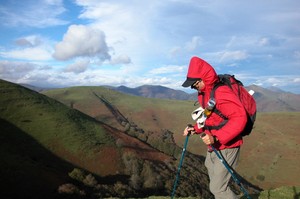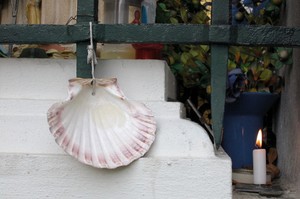Paris to the Pyrenees: A Skeptic Pilgrim Walks the Way of St. James
- SUBSCRIBE
- ALREADY SUBSCRIBED?
BECOME A BONJOUR PARIS MEMBER
Gain full access to our collection of over 5,000 articles and bring the City of Light into your life. Just 60 USD per year.
Find out why you should become a member here.
Sign in
Fill in your credentials below.
 It is probably safe to say that anyone raised Catholic knows about the Way of St. James. I was not raised Catholic, but I was vaguely aware that there was a Christian pilgrimage site in northern Spain—Santiago de Compostela—that had been of major importance in the Middle Ages. I was somewhat surprised to learn, however, that walking the Way of St. James is hardly a thing of the past. Though the number of pilgrims had trickled to a very small number by the early 1980s, there has been a steady increase in the years since. Today thousands of pilgrims follow the same trails travelers have taken since the ninth century.
It is probably safe to say that anyone raised Catholic knows about the Way of St. James. I was not raised Catholic, but I was vaguely aware that there was a Christian pilgrimage site in northern Spain—Santiago de Compostela—that had been of major importance in the Middle Ages. I was somewhat surprised to learn, however, that walking the Way of St. James is hardly a thing of the past. Though the number of pilgrims had trickled to a very small number by the early 1980s, there has been a steady increase in the years since. Today thousands of pilgrims follow the same trails travelers have taken since the ninth century.
After 20 years of living and working in France, David Downie, author of Paris, Paris: Journey into the City of Light as well as many books on food and travel, along with his wife, photographer Alison Harris, set out on the Way of St. James not because of its religious significance, but in spite of it. As he explains in the opening pages of Paris to the Pyrenees: A Skeptic Pilgrim Walks the Way of St. James,
“Outwardly, the irrepressible desire I felt to hike across France had little to do with spirituality…I simply felt the need to make my own mental map of the country by walking across it step by measured step…I also needed to reinvent myself from the bottom up, restore something I’d lost, discover things I’d never tried to find…and ask the big questions again…Among those fundamentals was, did I want to stay alive, or did I prefer to explode like an over-inflated balloon?”
A health crisis was the immediate impetus for his decision to go on the road. But it wasn’t only that, Downie says. “I was exhausted by flippancy and the forced cleverness of corporate magazine writing. Crossing France on foot, starting in Vézelay, was something I’d always dreamed of doing, in part because Burgundy was so green and gorgeous, in part because of its historical associations with Rome and the ancient world…The only hitch as far as I could see was religion.”
 So it was that he and Harris set out on their unconventional pilgrimage, a 750-mile walk through France, starting in Vézelay and ending at an abbey in Roncesvalles. The book, richly illustrated with Harris’s color photographs, is not only a fascinating journey through France on foot, with illuminating glimpses into French history from prehistoric times to the present. Downie also shares his idiosyncratic observations and provocative musings about a variety of topics, from connections between the Roman and American empires, to the character of Francois Mittérand, to the shadow of both Nazi collaboration and the French Resistance that falls across the Morvan, an extension of the Massif Central through which they hiked.
So it was that he and Harris set out on their unconventional pilgrimage, a 750-mile walk through France, starting in Vézelay and ending at an abbey in Roncesvalles. The book, richly illustrated with Harris’s color photographs, is not only a fascinating journey through France on foot, with illuminating glimpses into French history from prehistoric times to the present. Downie also shares his idiosyncratic observations and provocative musings about a variety of topics, from connections between the Roman and American empires, to the character of Francois Mittérand, to the shadow of both Nazi collaboration and the French Resistance that falls across the Morvan, an extension of the Massif Central through which they hiked.
It is also an intimate, personal journey, the author sharing his candid ruminations about his search, and the revelations it held for him. “Did anyone literally believe there were winged angels, glowing saints and an all-powerful creature shaped like a man watching from above?” he asks himself, at one point.
“Sadly, I knew the answer was yes….there were many, starting with members of my own family, people I loved and respected but could no longer have a civil conversation with, so bent were they on proselytizing. But, at the same time, I had to wonder whether I’d been too literal in the opposite way all these years, whether my wayward life of gluttony and materialism had led me into a backstreet leading to the side door of what? Perception? Tolerance?”
 And while he writes of being moved by religious structures, writings, music, and other “trappings” (my word, not his) of Christianity at various points along the way, momentarily yielding to emotion does not cause him to abandon his skepticism, or yield to the temptation of finding easy answers to difficult questions. There is, for example, never a tidy, definitive answer to the question he is asked by the host in a chambre d’hôte, early on—“Do you know why you’re doing the pilgrimage?”—a question that Downie freely admits unsettles him.
And while he writes of being moved by religious structures, writings, music, and other “trappings” (my word, not his) of Christianity at various points along the way, momentarily yielding to emotion does not cause him to abandon his skepticism, or yield to the temptation of finding easy answers to difficult questions. There is, for example, never a tidy, definitive answer to the question he is asked by the host in a chambre d’hôte, early on—“Do you know why you’re doing the pilgrimage?”—a question that Downie freely admits unsettles him.
This book offers, among other pleasures, the chance to vicariously travel with Downie and Harris as they encounter a variety of local characters—not all of them French, quite a few of them transplanted Parisians—as well as to experience the lush beauty of the Burgundian countryside, through Harris’s lens as well as Downie’s prose, which ranges from the sardonic to the lyrical, and is honest in both cases.
Much of the time they are trekking through Burgundy they are alone, passing through villages that are almost eerily quiet, and frustratingly devoid of places for travelers to eat. There are other annoyances too: for example, motorcyclists that interrupt the peacefulness and solitude of their walk along ancient Roman roads and destroy, at least momentarily, whatever peace, tranquility and escape from the maddening cacophony of modern life have been so hard won along the road. And there are the inevitable uncomfortable moments when, as Americans in Europe, they find themselves being expected to answer for the sins of their nation, no matter how they may feel personally about some of its policies themselves.
 There are also moments of comedy, not easily explained (you have to be there), but rest assured that there are many grins and even some laugh out loud moments along the way. Though the account is Downie’s, and Harris plays the role of a sidekick in the narrative, she is a sidekick who can definitely hold her own, a perfect complement and foil to his somewhat curmudgeonly, irreverent personality. She lights candles in the churches along the way, poses insightful questions, and presents him with perfectly timed challenges when flights of intellectual fancy threaten to take him away, affectionately bringing him back down to earth. “I sense that you’re about to come up with a theory linking mosquitoes and Druids or water nymphs,” she says at one point. “Have you had any revelations yet, or are we still in the pointless meandering stage?” And when Downie’s rejoinder is that the more churches he goes into, the more he finds Buddhism attractive, her reply is ready. “That’s okay, that’s perfectly valid,” she says. “Once upon a time you scoffed at Buddhists the way you scoffed at Catholics. You’re becoming more tolerant, though you probably don’t realize it yet.”
There are also moments of comedy, not easily explained (you have to be there), but rest assured that there are many grins and even some laugh out loud moments along the way. Though the account is Downie’s, and Harris plays the role of a sidekick in the narrative, she is a sidekick who can definitely hold her own, a perfect complement and foil to his somewhat curmudgeonly, irreverent personality. She lights candles in the churches along the way, poses insightful questions, and presents him with perfectly timed challenges when flights of intellectual fancy threaten to take him away, affectionately bringing him back down to earth. “I sense that you’re about to come up with a theory linking mosquitoes and Druids or water nymphs,” she says at one point. “Have you had any revelations yet, or are we still in the pointless meandering stage?” And when Downie’s rejoinder is that the more churches he goes into, the more he finds Buddhism attractive, her reply is ready. “That’s okay, that’s perfectly valid,” she says. “Once upon a time you scoffed at Buddhists the way you scoffed at Catholics. You’re becoming more tolerant, though you probably don’t realize it yet.”
I won’t ruin the ending for you, but I will say that Harris has almost the last word in their running dialogue. And if you want to know what that is, you’ll just have to read the book.
A word of advice? Don’t peek! Every page of this book is worth reading, and in order to understand the ending, you’ll have to have been there for the whole journey.
Photo credits: ©Alison Harris
Janet Hulstrand is a writer, editor and teacher based in Silver Spring, Maryland. She teaches literature classes at Politics & Prose bookstore in Washington, D.C. and Writing from the Heart workshops in France and in the U.S. Each summer she teaches “Paris: A Literary Adventure,” in Paris for the Queens College, CUNY Education Abroad Program..
More in book preview, book review, David Downie, new book, Paris book reviews, Paris books




